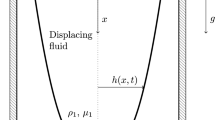Abstract
For many natural turbulent dynamic systems, observed high dimensional dynamic data can be approximated at slow time scales by a process X t driven by a systems of stochastic differential equations (SDEs). When one tries to estimate the parameters of this unobservable SDEs systems, there is a clear mismatch between the available data and the SDEs dynamics to be parametrized. Here, we formalize this Indirect Observability framework as follows.
We consider an unobservable centered stationary Gaussian process X t with covariance function K(u,θ)=E[X t X t+u ], parametrized by an unknown vector θ which lies in a compact subset Θ of ℝp. We assume that the only observable data are generated by centered stationary processes \(Y_{t}^{\varepsilon }\), indexed by a scale separation parameter ε>0. These approximating processes have arbitrary probability distributions, exponentially decaying covariances, and are assumed to converge to X t in L 4 as ε→0. We show how to construct estimators of the underlying parameter vector θ which depend only on the observable data \(Y_{t}^{\varepsilon }\), and converge to the true parameter values as ε→0.
We study adaptive subsampling schemes involving [N(ε)+k(ε)]→∞ observations \(V_{n} = Y^{\varepsilon }_{n \Delta(\varepsilon )}\) extracted from the approximating process \(Y^{\varepsilon }_{t}\) by subsampling at time intervals Δ(ε)→0. We focus on parameter estimators which are smooth functions of subsampled empirical covariance estimators \(\hat{r}_{k}(N,\Delta)\) associated to non vanishing time lags k(ε)Δ(ε) tending to fixed positive limits as ε→0.
We show that provided lim ε→0 N(ε)Δ(ε)=+∞, these subsampled approximate covariance estimators converge in L 2 to the true covariance function K(u,θ) of X t for all u,θ. Applying a generic version of the method of moments suitably boosted up by adequately adjusted multiple subsampling schemes, we show that this implies, in a very wide range of situations, the existence of consistent estimators \(\hat{\theta}(\varepsilon )\) of the unknown parameter vector θ, based only on adequately subsampled approximate data \(Y^{\varepsilon }_{t}\).
Similar content being viewed by others
References
Ait-Sahalia, Y., Mykland, P., Zhang, L.: How often to sample a continuous-time process in the presence of market microstructure noise. Rev. Financ. Stud. 18(2), 351 (2005)
Arnold, L., Imkeller, P., Wu, Y.: Reduction of deterministic coupled atmosphere–ocean models to stochastic ocean models: a numerical case study of the Lorenz–Maas system. Dyn. Syst. 18(4), 295–350 (2003)
Azencott, R., Dacunha-Castelle, D.: Series of Irregular Observations: Forecasting and Model Building. Springer, Berlin (1986)
Azencott, R., Beri, A., Timofeyev, I.: Adaptive sub-sampling for parametric estimation of Gaussian diffusions. J. Stat. Phys. 139(6), 1066–1089 (2010)
Azencott, R., Beri, A., Timofeyev, I.: Sub-sampling in parametric estimation of stochastic differential equations from discrete data (2010, submitted)
Barndorff-Nielsen, O., Shephard, N.: Estimating quadratic variation using realized variance. J. Appl. Econom. 17(5), 457–477 (2002)
Berner, J.: Linking nonlinearity and non-Gaussianity of planetary wave behavior by the Fokker–Planck equation. J. Atmos. Sci. 62, 2098–2117 (2005)
Crommelin, D., Vanden-Eijnden, E.: Diffusion estimation from multiscale data by operator eigenpairs (2010, submitted)
Culina, J., Kravtsov, S., Monahan, A.H.: Stochastic parameterisation schemes for use in realistic climate models J. Atmos. Sci. 68, 284–299 (2010)
DelSole, T.: A fundamental limitation of Markov models. J. Atmos. Sci. 57, 2158–2168 (2000)
Deuflhard, P., Schütte, C.: Molecular conformation dynamics and computational drug design. In: Applied Mathematics Entering the 21st Century: Invited Talks from the ICIAM 2003 Congress, p. 91. Society for Industrial Mathematics, Philadelphia (2004)
Franzke, C., Majda, A.J.: Low-order stochastic mode reduction for a prototype atmospheric GCM. J. Atmos. Sci. 63, 457–479 (2006)
Franzke, C., Majda, A.J., Vanden-Eijnden, E.: Low-order stochastic mode reduction for a realistic barotropic model climate. J. Atmos. Sci. 62, 1722–1745 (2005)
Hasselman, K.: Stochastic climate models. Part I: Theory. Tellus 28, 473–485 (1976)
Heston, S.: A closed-form solution for options with stochastic volatility with applications to bond and currency options. Rev. Financ. Stud. 6(2), 327 (1993)
Hummer, G.: Position-dependent diffusion coefficients and free energies from Bayesian analysis of equilibrium and replica molecular dynamics simulations. New J. Phys. 7, 34 (2005)
Majda, A.J., Timofeyev, I., Vanden-Eijnden, E.: A priori tests of a stochastic mode reduction strategy. Physica D 170, 206–252 (2002)
Majda, A.J., Timofeyev, I., Vanden-Eijnden, E.: Systematic strategies for stochastic mode reduction in climate. J. Atmos. Sci. 60(14), 1705–1722 (2003)
Papavasiliou, A., Pavliotis, G.A., Stuart, A.: Maximum likelihood drift estimation for multiscale diffusions. Stoch. Process. Appl. 119(10), 3173–3210 (2009)
Pavliotis, G.A., Stuart, A.: Parameter estimation for multiscale diffusions. J. Stat. Phys. 127, 741–781 (2007)
Zhang, L., Mykland, P., Ait-Sahalia, Y.: A tale of two time scales. J. Am. Stat. Assoc. 100(472), 1394–1411 (2005)
Author information
Authors and Affiliations
Corresponding author
Rights and permissions
About this article
Cite this article
Azencott, R., Beri, A. & Timofeyev, I. Parametric Estimation of Stationary Stochastic Processes Under Indirect Observability. J Stat Phys 144, 150–170 (2011). https://doi.org/10.1007/s10955-011-0253-4
Received:
Accepted:
Published:
Issue Date:
DOI: https://doi.org/10.1007/s10955-011-0253-4




